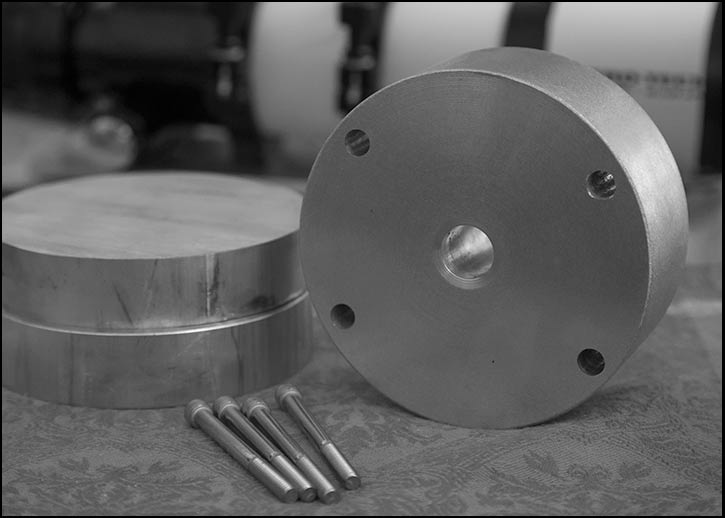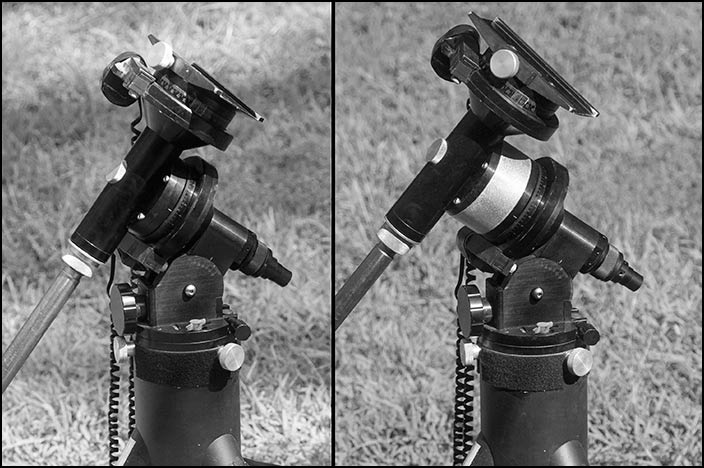Can I have an extension?
8/23/2015. How about an extension for the RA axis on the G11? Losmandy is offering an upscale version of this for $300. A dirt simple version has been selling in Europe for $400. I never knew what they were for until the prospect of shooting some long exposures that cross the meridian came along. The extension allows the housing for the declination gear to clear the right ascension stepper motor, and that, in turn, allows the head to track past the meridian. A spacer on the RA axis may or may not let me track as far beyond the meridian as the A-P mount does or pick up targets as far in advance of the meridian, but even a couple of hours either way would be very welcome when set up under the wide sky of the Blue Ridge Parkway (or Catron County).
However, ahem, I am damned if I am going to pay that much for a spacer, no matter how artfully Scott has executed the design. Some amateurs have been cobbling them up on Cloudy Nights for the last few years. There really is nothing subtle about it.
So I've ordered metal stock (5-inch diameter 6061 aluminum, two 1-inch and one 2-inch lengths). The 2-inch piece should be close to ready as is. Maybe it will need to be faced. It will surely have to be bored to allow the polar alignment 'scope to see Polaris. I'll need four holes to permit the dec axis to be bolted on using the original tapped holes. I pulled one of the bolts to determine its size and pitch -- the original is just a 1/4x20 stainless steel socket head bolt one inch in total length. I'll need four, 2 inches longer. Scott's kit also extends the declination head 3/4 inch, and that's one reason I ordered the 1-inch bars. I don't know why the dec head needs to be moved, but I'll be ready if it does. And, if 2-inches isn't enough extension to clear the motor, I can stack one of the 1" pieces to get half again as much room. (I looked at some foot-long 5" OD, 3" ID tubing which would be lighter and more elegant, but which would be a fight to cut and would certainly have needed lathe work to clean up after I mangled it to length.)

8/27/2015. Even though aluminum is a light metal, a 5-inch disk of it 2-inches thick has some heft. It's just about the largest diameter my 19th century Barnes lathe can grip, but grip it it did. I punched a 3/4-inch hole through the axis for the polar alignment 'scope to look through, center-punched locations and drilled slightly over-sized holes for the four bolts that hold the declination housing, took a couple of beauty cuts to insure that the end surfaces are reasonably smooth and parallel, turned a couple of millimeters of relief into both edges, and now await the arrival of longer bolts. Things seem to match up just fine when dry fitting the extension to the G11. So far, so good. One clear night and I'll see if I can make multi-hour exposures beginning in the eastern sky and finishing in the western sky, as intended. Do I leave it in natural aluminum or paint it? After star-trials, I hope that's my most pressing issue. It would be a good piece to anodize --later.
8/28/2015. It turns out that it's a PITA to install -- awkward to hold, align, start the first bolt --so, yeah, maybe I'll paint it in situ, but that's about my limit for prettification in the immediate future.

Seems to work: depending on the OTA and declination, the G11 can now track from horizon to horizon. Prior to this mod, no matter the OTA load or the dec toward which it was aimed, the declination gear housing collided with the RA stepper motor 45 minutes of RA east of the meridian. Stay tuned for real-life experiments under the stars.
Also today: I cleaned up an old 9x60 straight-through Orion finder and put its collimating rings on an Arca-Swift style plate. Matching clamps are bolted to tube rings of the 10"F4 Newtonian and AT65EDQ, so it's ready for duty on either OTA. Unless the angles mandate it, with this in place, there's no need to swap out the 50mm guider for the Orion 8x50 RACI finder. That plan only lasted a few days; it's not a bad idea, but I like this one better. Tonight anyway.
This is getting as bad an IBM parts reference. Here's a partial acronym & jargon dictionary. There may be a test:
Arca-Swift |
near-universal miniature dovetail system developed for mounting cameras to tripods |
AT65EDQ |
A compact astrograph of 65mm aperture including 4 lenses (the "Q" is for "Quadruplet") with "ED" ("Extra or Extreme Dispersion") glass, distributed by Astronomics under the "Astro-Tech" brand |
Dec |
Declination, north and south in the sky |
IBM |
International Business Machines, 20th Century manufacturing pioneer: perfected the production of acronyms for EDT (Every Damn Thing) |
Meridian |
line in the sky connecting due north and due south passing directly overhead |
OTA |
Optical Tube Assembly, the telescope itself, not including its mount |
PITA |
Pain In The... Assembly |
RA |
Right Ascension, east & west in the sky, generally expressed as time. 24 hours is all the way around. 1 hour of RA = 15 degrees. So "45 minutes of RA" is a little less than that. |
RACI |
Right Angle Correct Image, a finder with a bent optical path, avoiding a bent neck, which presents an un-inverted view as in binoculars rather that flipped all around as in a simple telescope
|
8/30/2015. One small step. It doesn't feel like much right now, but check with me the first time I set up and take down the RV kit. I bound a 25 foot USB cable, 12v extension, and a guide cable into one umbilical and cobbled up some semblance of a reel to store it. Stash the combined cables under the dinette with the computer ends available via the cable grommet at the edge the aft cushion. Just feed the three-part bundle out through the electrical access panel, go outside, take it to the telescope, and voila, a USB cable for the guide camera or for the solar camera, an RJ11 cable for the guide port on the G11, and a 12v power extension for whatever needs it. Attach the GPUSB adapter and a computer at the dinette, make some coffee and have at it. When done, unplug at the 'scope, pull the umbilical back in, roll it up, and done. We'll see.
Except where noted, deep-sky photos are made with an SBIG ST2000XM CCD behind a 10-inch Astro-Tech Ritchey-Chretien carried on an Astro-Physics Mach1GTO. The CCD is equipped with Baader wide- and narrow-band filters. The internal guide chip of the CCD most often keeps the OTA pointed in the right direction (I'll let you know when an OAG or guidescope takes its place). Camera control and guiding are handled by Maxim DL 5.12. The stock focuser on the AT10RC has been augmented with Robofocus 3.0.9 using adapters turned on the lathe downstairs. A Canon 6D and a modded 50D find themselves mounted on an Orion 10" F4 Newtonian or carrying widefield glass on an iOptron Skytracker. Beginning in May 2013, PixInsight has taken over more and more of the heavy lifting -- alignment, stacking, gradient removal, noise-reduction, transfer function modification, color calibration, and deconvolution. Photoshop CS4 et seq and the Focus Magic plugin get their licks in, too.
:: top ::